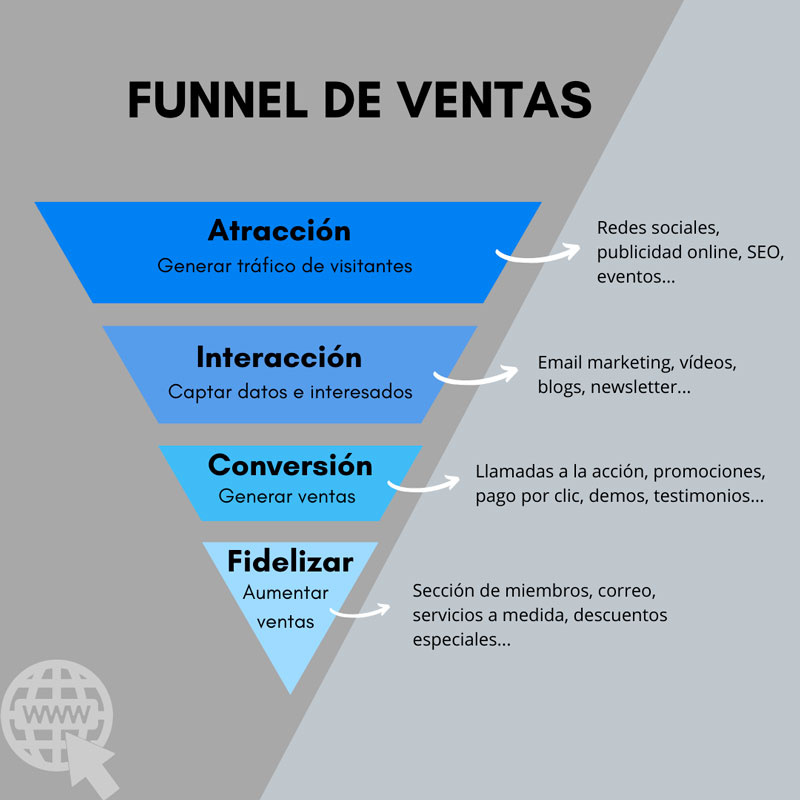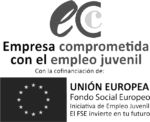In today's digital world, companies sin in setting their objectives on attracting customers and capturing their attention through different online channels such as social networks, SEO..... But what is the point of thousands of visits if none of them make a purchase on our website?
This is where the term sales funnel fits in. Although there is a lot of information about the sales funnel, as we mentioned at the beginning, few companies focus their main objectives on it.
The main objective of the sales funnel will be to support strategies or actions that aim to influence the purchasing decisions of visitors in order to convert them into customers. With this, we will ensure that customers do not leave the website as they have come.
In this post we will teach you what a sales funnel is and why it is so necessary to implement it in your company.
What is a sales funnel
The sales funnel is a model in which the visitor's journey is divided into different stages in order to understand, optimise and guide each one of them in order to achieve their main objective; to follow their process from the first contact until they become a customer.
We could also define it more simply as the process of attracting strangers, converting them into information providers or leads and, at the end of the funnel, transforming them into customers.

What is the funnel funnel for in digital marketing?
At the beginning of this post I mentioned the main objective that the sales funnel aims to achieve, but what other objectives can it help me to achieve?
- Confidence
If we manage to improve the relationship of trust with users, making use of interaction with them, engagement and the company's image through the sales funnel, we will be able to show them that we are a benchmark in the sector and reach groups of people who do not yet know you.
- Strangers become customers.
Knowing who comes to your website, with names and surnames to know what they are interested in is a task that you will also achieve with the sales funnel. With this you will ensure that all the actions you carry out will be backed up by all this information.
-Increased turnover.
For the sales funnel to be effective and profitable, it must have a front end and a back end.
This means that some offers have to be visible, but others should only be visible to people passing through certain steps. This gives us the opportunity to offer complementary or related products to the main product.
We must know the objectives, but... What are the keys to building a good sales funnel?
Important elements in a sales funnel
A well-defined business model: it is very important to have clear points such as revenue streams, different products or services...
A well-defined buyer persona: a product can have different buyer personas as its target audience.
Offer they can't resist: consumers nowadays buy results, so don't just focus on describing the product by its features.
Traffic control: without quality traffic to feed the funnel, the funnel will not be as effective.
Content that works: it is very important to know at which stage of the sales funnel the user is at in order to offer the most appropriate content.
Lead Magnet: webinars, events, workshops, ebooks... To be effective they must be in line with the company's business model.
Squeeze page: page to download the data obtained in the lead magnet.
OTO offer: this is about "forcing" the user to make a hot decision with an entry-level product at a reduced price.
Up selling: getting customers to buy more than they intended to buy.
Down selling: the customer reaches the limit at which he pays less for less product or service.
Once we are clear about the objectives and elements of the sales funnel, it is time to take action and implement them.
Stages of the sales funnel
In order to carry out a good sales funnel, we must be clear about the type of content that we are going to offer each user according to the phase of the funnel in which they are. The first phase will be awareness or TOFU, where we will create generic content that responds to the doubts or needs of users who have the first contact. This is followed by the MOFU phase. In this phase, the user will already have a clearer idea of what they want, so what they need is more specialised content, in exchange for offering their details and, therefore, becoming a lead.
Finally, we will find the BOFU phase in which we will close the sale by offering the user resources so that they stay with us for much longer, in other words, we make them loyal.





